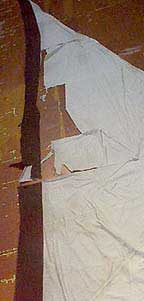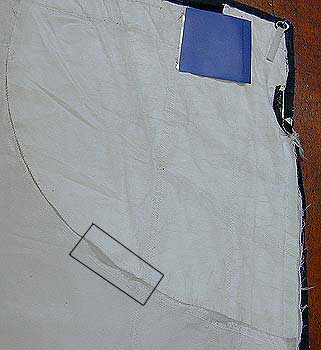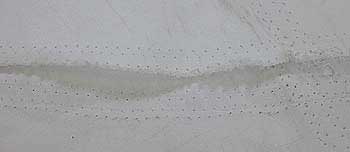
CLEWLESS IN SAN FRANCISCO
I would like to share with you some of the things which were learned and relearned from that experience. First and foremost, an exposed roller furling sail is not that happy in even 50 knots of breeze! (A mainsail which furls inside the mast is less exposed to wind damage.) If anything slips, or goes a little wrong, and the sail starts to unfurl, the sail has a very big problem. Usually a terminal problem. The sail will start to flog violently. If the problem is not attended to promptly, the sail will literally beat itself to pieces. The sound has been called a sailmakers' symphony... I talked with Peter Minkwitz, a marine surveyor, who related stories about masts which were shaken so hard by flogging sails that the light bulbs in the mast were gone! Think what the swages and shroud terminals must be going through during this kind of shaking! So what are common threads (no pun intended!) in the furling jib failures? In all cases somehow the jib starts to partially unfurl. This means it is either unwrapping itself from around the headstay (a problem with the jib sheets), the furler drum is allowed to rotate (a problem with the furling line), or the sail is "creeping out" because it was furled too loosely. Let's start by looking at why the jib thinks it is going to stay furled in the first place. When you furl the sail, the furling line causes the furling drum and extrusion to rotate, rolling the sail up around the headstay. After the sail is completely furled, the tension in the jib sheets is trying to unwind the system. For the jib to stay furled, the strain between the furling line (wind up), and the jib sheets (unwind) must remain in balance. If either one of these lines becomes slack, the jib is prone to unfurl. Alameda rigger Jack Scullion points out that this balance is never established if the jib sheets are removed from the jib cars, coiled up and hung on the bow pulpit. When the sheets are stored forward, they are just pulling down. Even if there are several wraps of the sheet around the sail, with all the banging and shaking of the rig in a big blow, these turns will start to loosen up and slide down the jib, allowing the clew to start unwinding from around the headstay. Another way to court disaster is to remove the sheets altogether and use a sail tie or shock cord to hold the jib closed. There must be tension on the jib sheets, holding the jib tightly against the forestay. There have some comments on the net about using one of the sheets to pull aft, while the other sheet is removed from the jib car and led forward to pull straight down. This prevents the clew from migrating up the the furled sail, loosening the tightness of the furl, which might allow the wind to get underneath the leech, and over time, start the sail flogging. This seems like a very good idea. The furling line itself is often at fault. After furling the jib be SURE the furling line is cleated off in a formal fashion, on a real cleat, or tied off in such a way that it cannot slip out. Better yet, put a few turns around a winch, then to a cleat. The winch provides a large, round surface for the furling line to dissipate the constant strain and shocks without cutting itself. On one sail we saw, the furling line parted. The sail unfurled almost instantly and self distructed in short order. If your furling line is old, or chafed, consider replacing it. Several jibs showed signs of the 'creep out' problem, where the sail was not furled very tight the last time it was put away. In this situation, the wind tends to get under the leech of the jib and start tugging on the outside layer. This has the effect of cinching up the inside layers, while exposing more sailcloth to the wind on the outside layer, which allows more wind to get underneath this bigger piece, so it pulls harder still. Pretty soon, parts of the leech will be flogging in the wind. If you know it's going to be WINDY, then the safest move is to get down to your boat, unfurl the jib and get it below. You don't have to fold it if you don't have time, you're by yourself, or it's already too windy. I know that removing the jib sounds extreme, but I also know you won't find YOUR jib hanging in ribbons off the furler the next time you walk down the dock. At the very least, check that the furling line is properly cleated, and re-tension the jib sheets. Another safeguard is to take the spinnaker halyard and wind it repeatedly around the tightly furled jib, in the opposite direction of the furl, to help hold the sail closed. Also in the safeguard category are the live-aboards. I have heard many stories of these folks retying boats, re-furling jibs, and helping out all over the place, at all hours of the day and night. If you have helpful live-aboards nearby, do something nice for them! By the way, if you know you won't be sailing for a while, like during the winter months, consider removing the jib from the furler and storing it below until the next time you sail. Remember: Your mother was right...take good care of your equipment, and your equipment will take good care of you!
|
Copyright ©2011 Pineapple Sails
2526 Blanding Avenue
Alameda, CA 94501 USA - directions
(510) 522-2200
 We
had numerous severely damaged furling jibs brought to us at Pineapple Sails, all casualties of a big blow
on Tuesday, December 12, 1995. The peak wind speed of 103 knots was measured at Pt. Blunt on Angel Island
in the middle of
San Francisco Bay. All the damaged sails we saw were sitting furled
on the forestay in their "normal" stowed position. Several of the sails came in with the jib sheets still attached to the
clew ring, but the clew
ring unattached to the sail...litterally clewless.
We
had numerous severely damaged furling jibs brought to us at Pineapple Sails, all casualties of a big blow
on Tuesday, December 12, 1995. The peak wind speed of 103 knots was measured at Pt. Blunt on Angel Island
in the middle of
San Francisco Bay. All the damaged sails we saw were sitting furled
on the forestay in their "normal" stowed position. Several of the sails came in with the jib sheets still attached to the
clew ring, but the clew
ring unattached to the sail...litterally clewless.  This is a photograph of the clew of a jib which
came un furled in a wind storm. The leech is to the right and the foot is at the top of the photograph. The
sail flogged long enough that essentially all the stitching which held
the clew reinforcement to the sail failed. But much more damaging than that is the fact that the sail cloth stretched
during all the flogging. The rectangle shows the area of the close-up below.
This is a photograph of the clew of a jib which
came un furled in a wind storm. The leech is to the right and the foot is at the top of the photograph. The
sail flogged long enough that essentially all the stitching which held
the clew reinforcement to the sail failed. But much more damaging than that is the fact that the sail cloth stretched
during all the flogging. The rectangle shows the area of the close-up below.
 In this close up you can see
how much the sail (bottom layer) as stretched
relative to the clew reinforcement (top layer). Before the flogging, the needle holes in the two layers
of cloth lined up.
In this close up you can see
how much the sail (bottom layer) as stretched
relative to the clew reinforcement (top layer). Before the flogging, the needle holes in the two layers
of cloth lined up.